Intro
Discover what a purchase order is, its process, and benefits, including procurement, invoicing, and contract management, to streamline business operations and supplier relationships.
A purchase order is a crucial document used in business transactions to formalize the purchase of goods or services from a supplier. It serves as a legally binding contract between the buyer and the seller, outlining the terms and conditions of the purchase, including the type and quantity of goods or services, prices, payment terms, and delivery details. The importance of a purchase order lies in its ability to protect both parties involved in the transaction by providing a clear and concise record of the agreement.
In today's fast-paced business environment, purchase orders play a vital role in streamlining procurement processes, ensuring that all stakeholders are on the same page, and minimizing the risk of misunderstandings or disputes. By using a purchase order, businesses can effectively manage their inventory, track expenses, and maintain a transparent and accountable record of all transactions. Whether you're a small startup or a large corporation, understanding the concept of a purchase order and its significance in business operations is essential for making informed decisions and driving growth.
The use of purchase orders has become increasingly prevalent in various industries, including manufacturing, retail, and construction, where the procurement of goods and services is a critical component of daily operations. By leveraging purchase orders, businesses can negotiate better prices, ensure timely delivery, and mitigate potential risks associated with procurement. Moreover, purchase orders provide a framework for resolving disputes or issues that may arise during the course of a transaction, helping to maintain a positive and productive relationship between buyers and suppliers.
Benefits of Using Purchase Orders

The benefits of using purchase orders are numerous and can have a significant impact on a company's bottom line. Some of the key advantages of using purchase orders include:
- Improved communication and clarity between buyers and suppliers
- Enhanced transparency and accountability in procurement processes
- Better management of inventory and expenses
- Reduced risk of misunderstandings or disputes
- Increased negotiating power for better prices and terms
- Streamlined procurement processes and improved efficiency
By incorporating purchase orders into their procurement strategy, businesses can experience significant cost savings, improved relationships with suppliers, and enhanced operational efficiency. Moreover, purchase orders provide a valuable audit trail, enabling companies to track and analyze their procurement activities, identify areas for improvement, and make data-driven decisions to drive growth and profitability.
Key Components of a Purchase Order
A purchase order typically includes several key components, including:- Buyer and supplier information
- Description of goods or services being purchased
- Quantity and unit price of goods or services
- Total cost and payment terms
- Delivery details, including date, time, and location
- Terms and conditions of the purchase
By including these essential elements, a purchase order provides a comprehensive and legally binding agreement that protects the interests of both parties involved in the transaction. Whether you're a seasoned procurement professional or just starting out, understanding the key components of a purchase order is crucial for navigating the complexities of business transactions and ensuring successful outcomes.
How to Create a Purchase Order
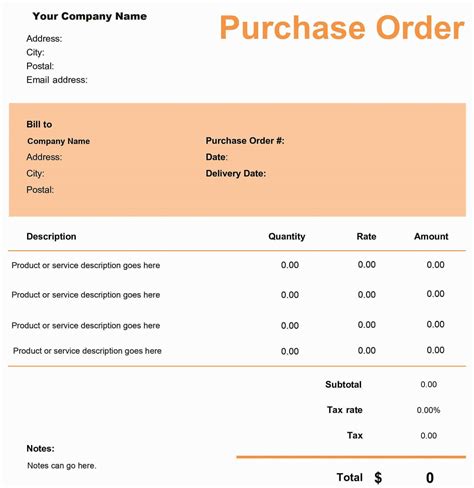
Creating a purchase order is a straightforward process that involves several steps, including:
- Gathering information about the goods or services being purchased
- Identifying the supplier and negotiating terms and conditions
- Determining the quantity and unit price of goods or services
- Calculating the total cost and payment terms
- Specifying delivery details, including date, time, and location
- Reviewing and approving the purchase order
By following these steps, businesses can create a comprehensive and effective purchase order that meets their needs and protects their interests. Whether you're using a manual or automated system, creating a purchase order requires attention to detail, clear communication, and a thorough understanding of the procurement process.
Best Practices for Managing Purchase Orders
To get the most out of purchase orders, businesses should follow best practices for managing these critical documents. Some of the key best practices include:- Using a standardized purchase order template
- Ensuring accuracy and completeness of purchase order information
- Reviewing and approving purchase orders in a timely manner
- Maintaining a centralized repository of purchase orders
- Tracking and analyzing purchase order data to identify trends and areas for improvement
By adopting these best practices, companies can streamline their procurement processes, reduce errors and discrepancies, and improve their overall operational efficiency. Whether you're a small business or a large enterprise, effective management of purchase orders is essential for achieving success in today's fast-paced and competitive business environment.
Common Challenges and Solutions

Despite the many benefits of using purchase orders, businesses may encounter common challenges and obstacles that can hinder their effectiveness. Some of the most common challenges include:
- Inaccurate or incomplete purchase order information
- Delays or discrepancies in delivery
- Disputes or misunderstandings with suppliers
- Inefficient or manual purchase order processes
To overcome these challenges, businesses can implement solutions such as:
- Automating purchase order processes using digital tools and software
- Implementing robust quality control measures to ensure accuracy and completeness
- Establishing clear communication channels with suppliers and stakeholders
- Providing training and support for procurement teams to improve their skills and knowledge
By addressing these common challenges and implementing effective solutions, companies can unlock the full potential of purchase orders and achieve significant improvements in their procurement processes and overall business performance.
Future of Purchase Orders
As technology continues to evolve and advance, the future of purchase orders is likely to be shaped by trends such as digitalization, automation, and artificial intelligence. Some of the potential developments that may impact the use of purchase orders include:- Increased adoption of digital purchase order platforms and software
- Growing use of artificial intelligence and machine learning in procurement processes
- Greater emphasis on sustainability and social responsibility in procurement decisions
- Increased focus on supply chain visibility and transparency
By staying ahead of these trends and developments, businesses can position themselves for success in a rapidly changing and increasingly complex business environment. Whether you're a procurement professional or a business leader, understanding the future of purchase orders and their role in shaping the procurement landscape is essential for driving growth, innovation, and profitability.
Gallery of Purchase Order Examples
Purchase Order Image Gallery
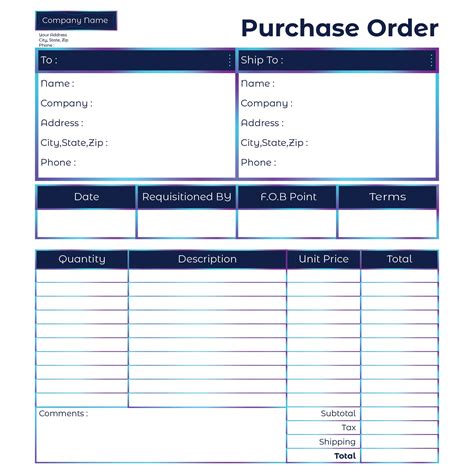
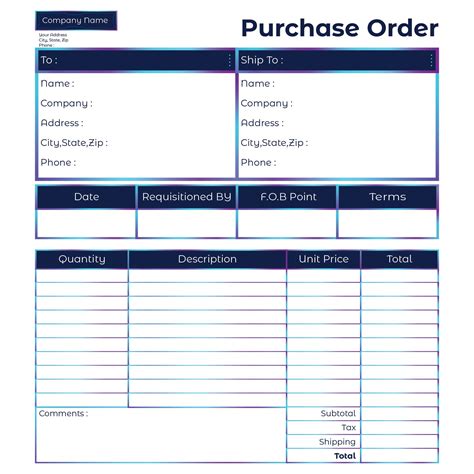
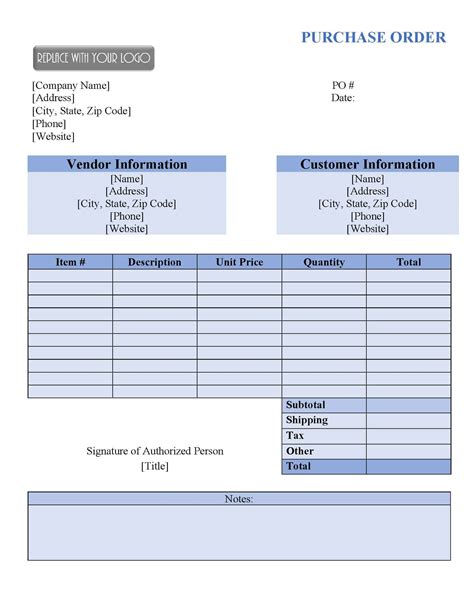
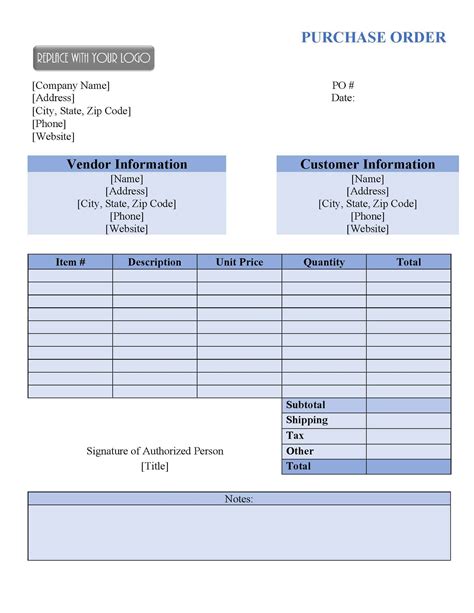

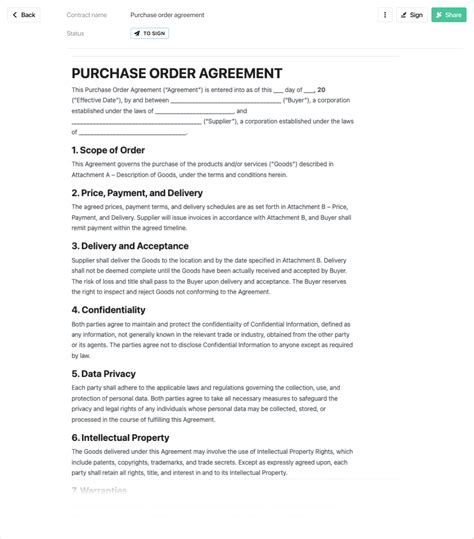
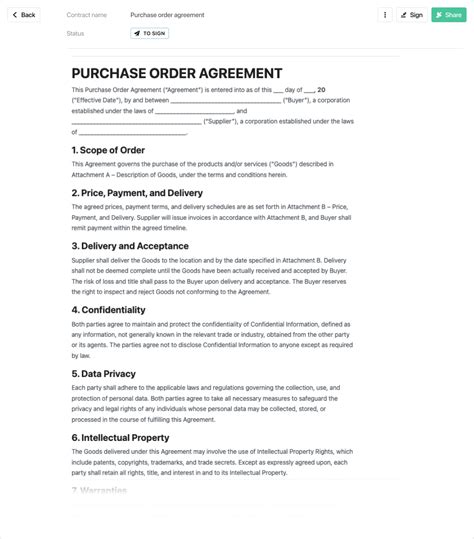
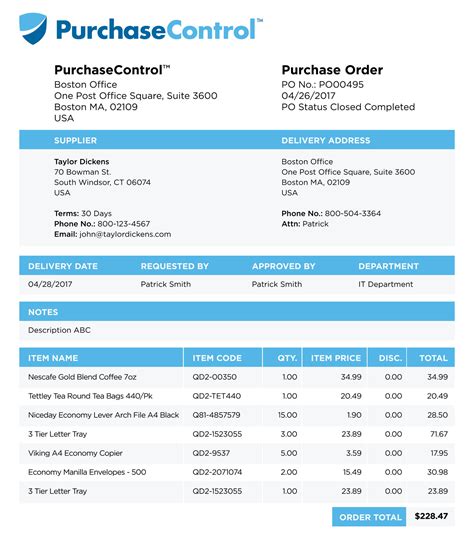
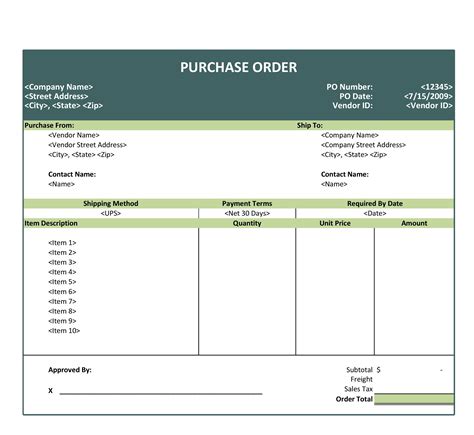
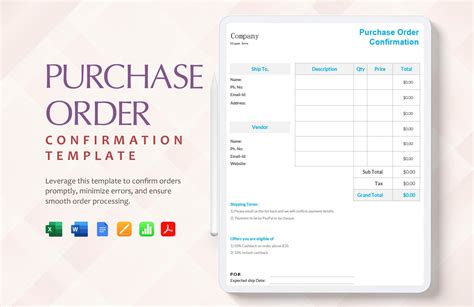
Frequently Asked Questions
What is a purchase order?
+A purchase order is a document used to formalize the purchase of goods or services from a supplier.
Why are purchase orders important?
+Purchase orders are important because they provide a clear and concise record of the agreement between the buyer and supplier, protecting both parties and minimizing the risk of misunderstandings or disputes.
How do I create a purchase order?
+To create a purchase order, gather information about the goods or services being purchased, identify the supplier and negotiate terms and conditions, determine the quantity and unit price, calculate the total cost and payment terms, and specify delivery details.
What are the benefits of using purchase orders?
+The benefits of using purchase orders include improved communication and clarity, enhanced transparency and accountability, better management of inventory and expenses, reduced risk of misunderstandings or disputes, and increased negotiating power.
Can I use a digital purchase order platform?
+Yes, digital purchase order platforms can streamline procurement processes, improve accuracy and efficiency, and provide real-time visibility into purchase order activity.
In conclusion, purchase orders play a vital role in business transactions, providing a clear and concise record of the agreement between the buyer and supplier. By understanding the importance of purchase orders, creating effective purchase orders, and managing them efficiently, businesses can unlock significant benefits and improvements in their procurement processes. Whether you're a procurement professional or a business leader, we encourage you to share your thoughts and experiences with purchase orders in the comments below, and don't forget to share this article with your network to help others understand the significance of purchase orders in driving business success.
